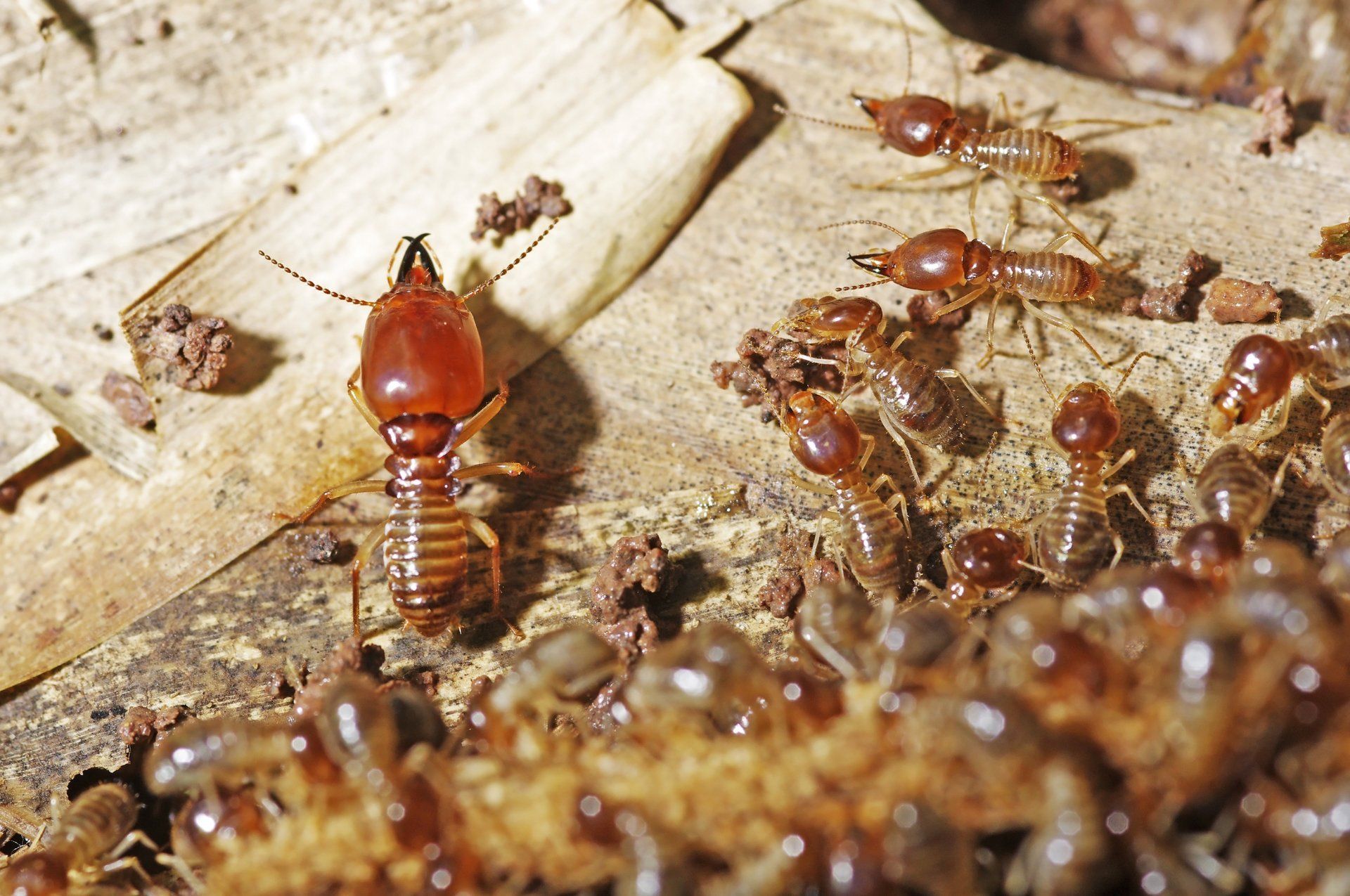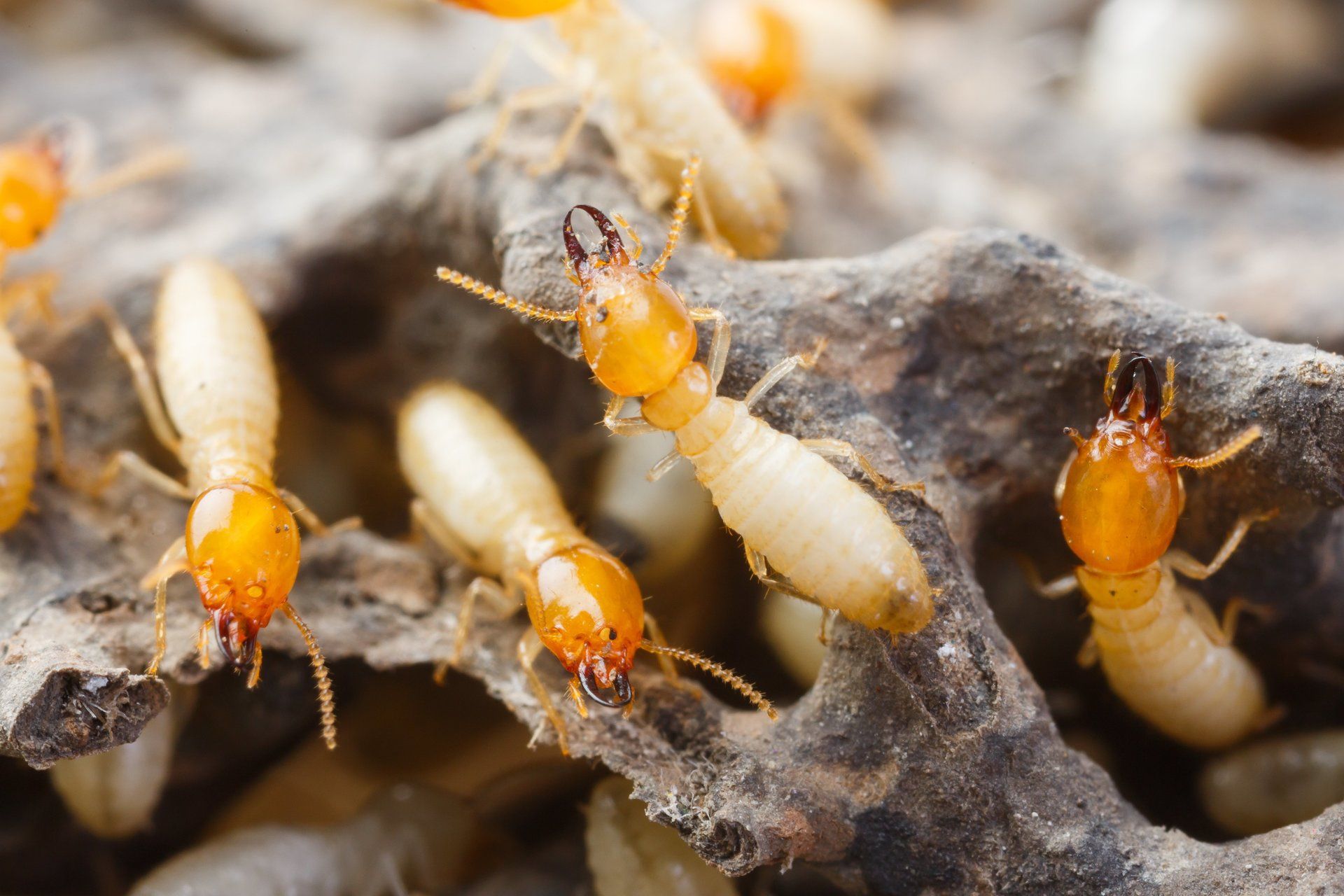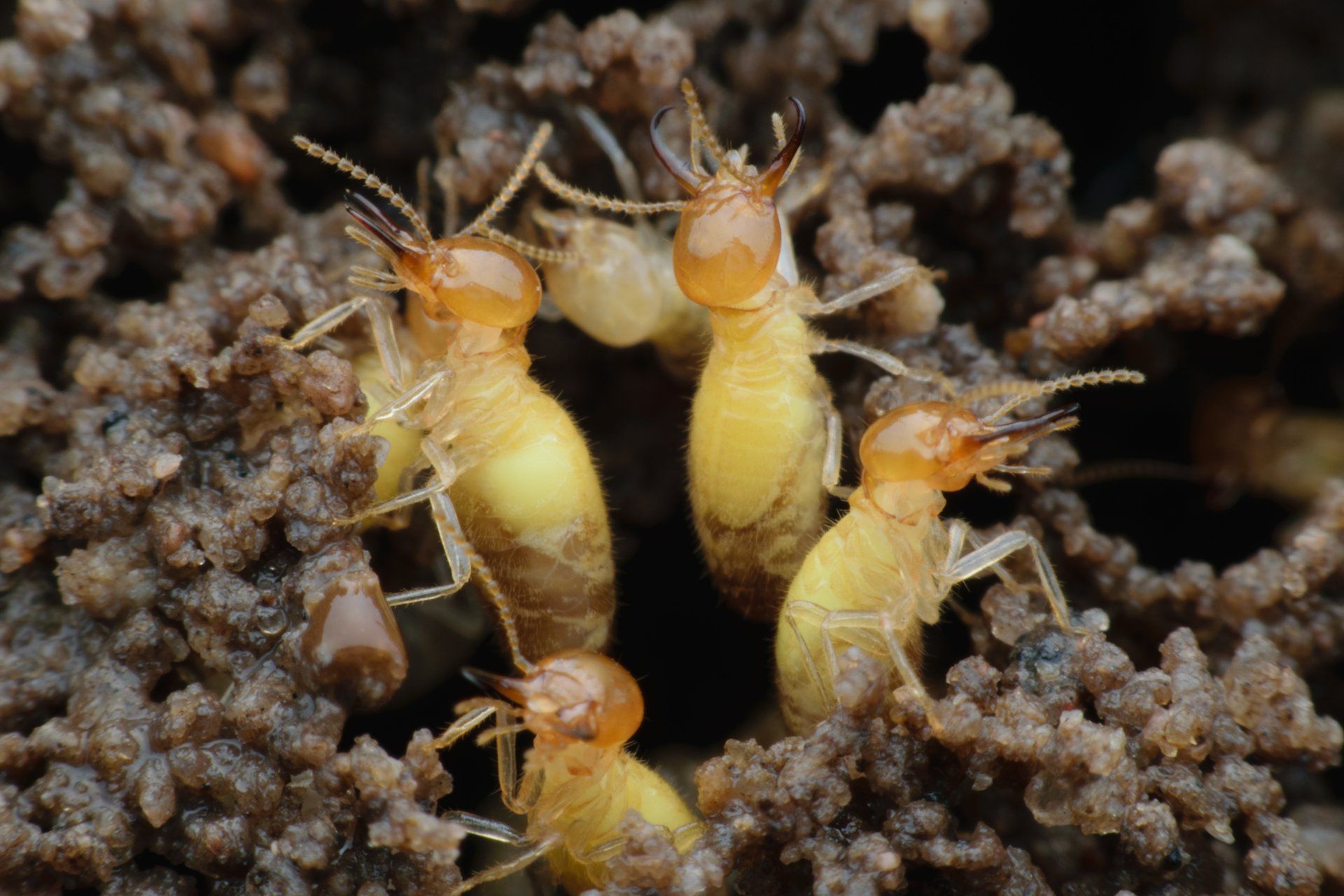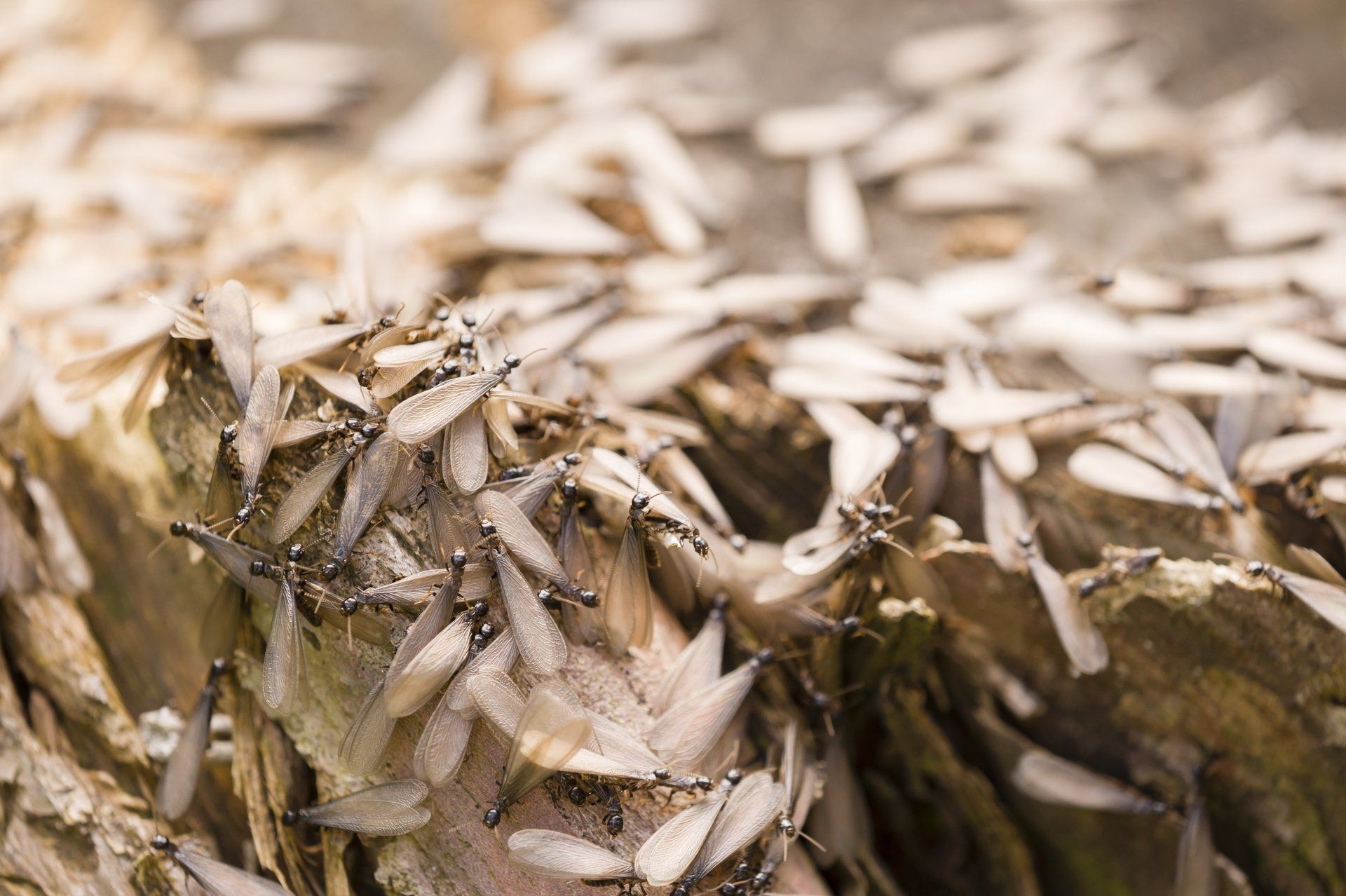Termites -SA
TERMITE (SOLDIER)

All termites live in nests or colonies. Individual classes (or "castes") of termites within the colony have their own roles and functions. Soldier termites defend the colony from attack. If a termite nest is disturbed, soldier termites will rush to "plug" any broken walls, tunnels ("mud tubes"), and/or areas where the nest has become vulnerable. As a result, you will, on occasion, see soldier termites outside of the colony itself.
Soldier termites resemble worker termites in several respects. For example, both castes have rounded bodies that are coloured a pale reddish-brown or white. However, a termite soldier can be easily distinguished from other kinds of termites. Look for termites that are larger than average, have heads that are darker or a different colour than their bodies and feature either protruding jaws or snouts. These soldiers make up about 1-10% of any given colony's termite population.
TERMITE (WORKER)

Commonly but erroneously called 'white ants' termites are the most destructive of wood-boring insects. They do not occur in the United Kingdom, but are widespread throughout the Tropics, the United States, Australasia and to a lesser extent Continental Europe. In addition to timber some species also attack standing trees, food crops and many other materials including plastics and rubber. Broadly speaking, they fall into two main groups: Its presence may therefore be accompanied by serious structural collapse of timber due to fungal decay.
Worker termites search out and collect food for the termite colony. Termite workers are also responsible for building and maintaining termite mud tubes and nests. They feed on cellulose, which is an essential component found in wood and grass. In nature, they’re helpful in the breakdown of dead and decaying materials. However, when worker termites seek to eat the wood in your home, they create devastating problems.
You can distinguish worker termites from other termites by their colour and size. Worker termites are pale or white, have rounded heads and bodies and straight antennae. They are smaller than the colony king and queen. Soldier termites, which defend the nest from ant attacks, also have pale or white bodies but possess dark heads and larger jaws. If you notice winged termites around your home, these are "swarming" termites. Like the king and queen, winged termites are “reproductive,” but they only lay eggs after they have flown away from the nest during swarming. Light brown to black in colour (depending on the species), winged termites are most likely to be visible in the spring.
TERMITE (QUEEN)

This wood-boring insect is related to the Common Furniture Beetle but is much larger. Its flight-hole is large and round (3mm diameter) and its bore dust is coarse and bun shaped. The larvae of this beetle are usually found in decaying oak and the life cycle from egg to adult can be as short as four years. In dry, sound wood the larvae may tunnel for up to twelve years before palpation and the cycle starts again. The Queen lays up to 30,000 eggs a day.
A subterranean termite queen can vary in colour from pale yellow-brown to black. Secondary reproductive in subterranean species are typically white or very light in colour – the same colour as worker termites for that species.
The role of the queen in a termite colony varies and changes over time. After pairing with a male, she begins her job as “founder” to get the colony started. She must locate a suitable nest site, help excavate it and then start producing eggs that will become workers.
The queen and king are groomed and fed by workers, which enter the royal cell through small openings in its hard-protective wall. Queens lay eggs at a steady rate every day. Workers move the eggs to incubation chambers.
Egg production is slow at first but increases year by year; the queen maintains peak egg performance for seven to 10 years. Once the secondary queens – which are produced within the colony – begin egg-laying, colony size (number of workers) increases rapidly.
The number of eggs produced by the queen varies depending on the species and the age of the queen. In tropical regions, egg production is continuous throughout the year, although there are seasonal fluctuations. In more temperate regions, termite egg production is often suspended during the cooler months.
After hatching, young immatures are taken to nursery chambers where they are fed and groomed by workers. They are moved to other chambers in the nest until their final moult into workers or soldiers.
A colony of about 1,000 workers at two years can multiply into 300,000 workers in five more years. Secondary queens are usually located in satellite nests away from, but connected to the main nest, so colonies can grow in size and number of individuals.
The queen, king and elates (termite swarmer’s) are considered the primary reproductive in a colony. In some cases, secondary or tertiary reproductive also can produce offspring. These secondary or tertiary reproductive do not have wings, although they may have wing buds.
When weather conditions are optimal, the queen produces elates, which will leave the nest to form new colonies.
When male and female winged termites mate to form a new colony, they first locate a suitable nest and hollow it out. Then, the queen begins laying eggs and cares for the first eggs. Once the queen lays enough eggs to establish a worker caste, the workers will begin caring for the eggs and expanding the size of the nest.
The queen is able to control the colony’s size and prevent the formation of secondary and tertiary reproductive through the production of a pheromone. Once the colony reaches a certain size, she may permit the development of secondary and tertiary reproductive. These reproductive create satellite nests near the colony and begin laying eggs. Once these satellite nests are established, the colony will begin to grow at an exponential rate.
The original queen in the colony is capable of chemically blocking development of the reproductive potential of all members of the colony. The king and/or queen produce a pheromone that circulates through the colony and inhibits the formation of other (secondary) reproductive.
The inhibitory pheromone produced by the queen prevents development of female secondary reproductive. This substance is circulated through the colony by immature stages that routinely consume the faeces of nestmates.
When the queen dies, production of the blocking pheromone stops, and secondary reproductive may be produced.
In the Reticulorumens species, the queen and king may be replaced by numerous secondary reproductive, and the colony may become very large with the added productivity of many queens.
A queen termite has a long lifespan and is typically the oldest termite in the colony. Termite queens can live 25 to 50 years, with peak egg production for up to 10 years. When the queen dies and the pheromone she uses to block reproductive’ development is no longer produced, a new queen will develop in the colony.
A queen termite is usually slightly larger in size than a worker termite of the same species.
Download PDF
Download this information in PDF format for Print purposes.
Download PDF
Our Videos
Watch our series of educational videos.
Watch Videos
SUBTERRANEAN TERMITES
FAMILY RHINOTERMITIDAE

Colour:
Creamy white to dark brown / black
Shape:
Long, narrow and oval
Size: ⅛ inch long
Overview
Subterranean termite colonies are organized into casts depending on tasks – workers, soldiers and reproductive. The characteristics of a subterranean termite are dependent on the termite’s role in the colony. Worker subterranean termites are ⅛ to ⅜ inch long. Soldier subterranean termites are of a similar body in length but are distinguished by their powerful mandibles and large brown heads. Reproductive subterranean termites ate approximately ½ inch long.
Habits
Subterranean termites live in underground colonies or in moist secluded areas above ground. They build distinctive “mud tubes” to gain access to food sources and to protect themselves from open air. Like other termite species, they feed on products containing cellulose. Subterranean termites swarm in the spring when groups of reproductive termites go off to start new colonies.
Threats
Subterranean termites are by far the most destructive termite species. The hard, saw-toothed jaws of termites work like shears and can bite off extremely small fragments of wood, one piece at a time. They can cause severe property damage.
Prevention
• Divert water away from your homes’ foundation with properly functioning downspouts, gutters and splash blocks. Repair leaking faucets, water pipes and AC units on the outside of the home.
• Reduce humidity in crawl spaces, attics and basement with proper ventilation.
• Store firewood at least 20 feet away from the house and 5 inches off the ground
• Keep mulch at least 15 inches from the foundation
• Routinely inspect the foundation of your home for signs of mud tubes, cracked or bubbling paint and wood that sounds hollow when tapped.
• Treat all timber frames, doors, window frames, etc. with a wood preservative that will prevent termites attacking any timber.
Did you Know?
• Live in colonies with as many as two million members
• Use their scissor-like jaws to eat wood 24 hours a day, seven days a week.
FORMOSAN TERMITES
FORMOSANUS

Colour:
Creamy white to brown
Shape:
Long, narrow and oval
Size: ½ inch long
Overview
Originally from China, Formosan termites are an extremely aggressive and destructive termite species. Formosan termites are a subterranean species of termites. Swarmer Formosan termites are about ½ inch in overall length, including their wings.
Habits
Formosan termites live in huge underground colonies, with an average of 350,000 workers, but can contain as many as several million termites. Formosan termites build intricate mud nests in the ground. In addition to structures, they are also known to infest trees, shrubs, utility poles, timber, railroad trusses and even boats.
Threats
A mature colony of Formosan termites can cause severe structural damage to a home in as little as six months. Prevention is key with this species. If dealing with an existing infestation, talk to a pest professional about Formosan termite treatment.
Prevention
• Divert water away from your home’s foundation with properly functioning downspouts, gutters and splash blocks. Repair leaking faucets, water pipes and AC units on the outside of the home.
• Reduce humidity in crawl spaces, attics and basement with proper ventilation.
• Store firewood at least 20 feet away from the house and 5 inches off the ground
• Maintain a one-inch gap between foundations
• Routinely inspect the foundation of your home for signs of mud tubes, cracked or bubbling paint and wood that sounds hollow when tapped.
• Treat all timber frames, doors, window frames, etc. with a wood preservative that will prevent termites attacking any timber.
Did you Know?
• Live in colonies with as many as two million members
• Use their scissor-like jaws to eat wood 24 hours a day, seven days a week.
DAMPWOOD TERMITES
FAMILY HODOTERMITIDAE

Colour:
Creamy white to brownish
Shape:
Long, narrow and oval
Size:
½ - ⅝ inch long
Overview
As the name suggests, dampwood termites infest wood with a high moisture content. dampwood termites are normally larger than other termite species. Bodies of king and queen dampwood termites range in size from ½ inch to ⅝ inch long and have two pairs of wings that are equal in size and shape, extending beyond their abdomen. Nymphs can be as long as ⅝ inch and worker dampwood termites are up to ¾ inch in size.
Habits
Dampwood termite colonies, like drywood termites, have no worker caste. The nymph dampwood termites take care of the kings and queens of the colony and feed the soldier caste. Drywood termites are usually found in logs, stumps, dead trees, fence posts and utility poles.
Threats
Because of their need for excessive moisture, dampwood termites are not often found in structures. However, these termites will infest sound wood if moisture is maintained, especially where wood is in contact with the ground or there is a moisture supply such as a leaky pipe. Care must be taken to avoid attracting dampwood termites to a structure as they can cause serious property damage.
Prevention
• Eliminate sources of moisture by diverting water away from your home’s foundation with properly functioning downspouts, gutters and splash blocks. Repair leaking faucets, water pipes and AC units on the outside of the home.
• Reduce humidity in crawl spaces, attics and basements with proper ventilation.
• Store firewood at least 20 feet away from the house and 5 inches off the ground
• Keep mulch at least 15 inches from the foundation and avoid wood-to-ground contact.
• Replace any damp or damaged wood on your home’s exterior.
Did you Know?
• Eat wood across the grain
• Create a series of chambers in wood, which are connected by tunnels with smooth walls, as if sandpapered.
DAMPWOOD TERMITES
FAMILY KALOTERMITIDAE

Colour:
Creamy white to brownish
Shape:
Long, narrow and oval
Size:
⅜ - 1 inch long
Overview
Drywood termites are social insects. They infest dry wood, like that found in attic framing. Unlike most termite species, drywood termites do not require contact with the soil. Swarming drywood termites fly into structures and infest wood directly.
Habits
Drywood termites form colonies of up to 2,500 members. Unlike subterranean termites, drywood termite colonies do not have a worker caste. The work is done by immature termites before they reach adulthood.
Threats
Drywood termites can infest structures and cause significant structural damage. They can chew through support beams, floors and walls, causing expensive repairs.
Prevention
Avoid wood-to-ground contact around the perimeter of your home Routinely inspect your home for signs of drywood termites. Pay special attention to window / door frames, trim, eaves, sliding and attics.
Did you Know?
Can be transported to new location via an infested piece of furniture, a picture frame, etc. Usually swarm on sunny, warm days after a sudden rise in temperature.

